Welcome to a culinary adventure that's going to excite the living daylights outta your taste buds! If you're a fan of Filipino cuisine or just love trying new and unique flavors, then you're in for a treat with this fan-favorite recipe.
As you take your first bite of this sizzling tofu sisig, you're greeted with the tangy notes of calamansi juice, the umami richness of soy sauce, the subtle sweetness of caramelized onions, and the fiery kick of red chili peppers. The fragrant aroma of garlic and scallion wafts through the air, teasing your nose with its irresistible scent.

Tofu sisig is the perfect dish to serve with my smokey eggplant ensaladang talong or adobong sitaw. It’s even pretty darn bangin’ served over a bed of kimchi fried rice or over a hot bowl of simple soy sauce noodles or curried noodles.
The combination of crispy, tender, tangy, savory, and spicy creates a symphony of flavors that's truly unforgettable. With every bite, you'll be treated to a harmonious medley of textures, from the crispy exterior of the tofu to the succulent and melt-in-your-mouth interior.
Jump to:
- 🥰Why you are going to adore the ever-loving heck outta this recipe
- 🇵🇭The Cinnamon Snail at the World Street Food Congress in Manilla
- 🌶️Notable ingredients and subsitutions
- 📖 How to make perfect vegan sisig
- 💡Serving ideas
- 💡Top tip
- 🤷♀️Recipe FAQs
- ✌️Other dishes that go great with this:
- Tofu sisig (crispy vegan Filipino tofu)
🥰Why you are going to adore the ever-loving heck outta this recipe
🧼 Effortless Cleanup: Craft tofu sisig at home with minimal cleanup using just one pan and simple techniques, making it accessible for even novice cooks.
🌶️ Customizable Bliss: This sisig is your culinary canvas—adjust the heat, sweetness, and veggies to suit your taste, making it uniquely yours.
✊ Protein-Packed Goodness: Ideal for vegetarians and vegans, tofu sisig offers a protein-rich, flavorful alternative to traditional meat-based sisig, showcasing the satisfying taste of soybean curd.
🇵🇭The Cinnamon Snail at the World Street Food Congress in Manilla

In 2016 I was chosen to represent the United States at the World Street Food Congress in the Philippines. That’s where I first learned about sisig, lechon, and so many Filipino recipes that I would go on to veganize. As some of you who subscribe to my email newsletter know, the event was tragic, and one of the young men helping us at the event passed away due to the terrible working conditions provided by the organizers. It was a crazy, eye-opening experience that made me respect and admire culinary workers in Southeast Asia more than ever.
It's also where I first fell in love with Filipino desserts like Budbud and Tupig!
🌶️Notable ingredients and subsitutions
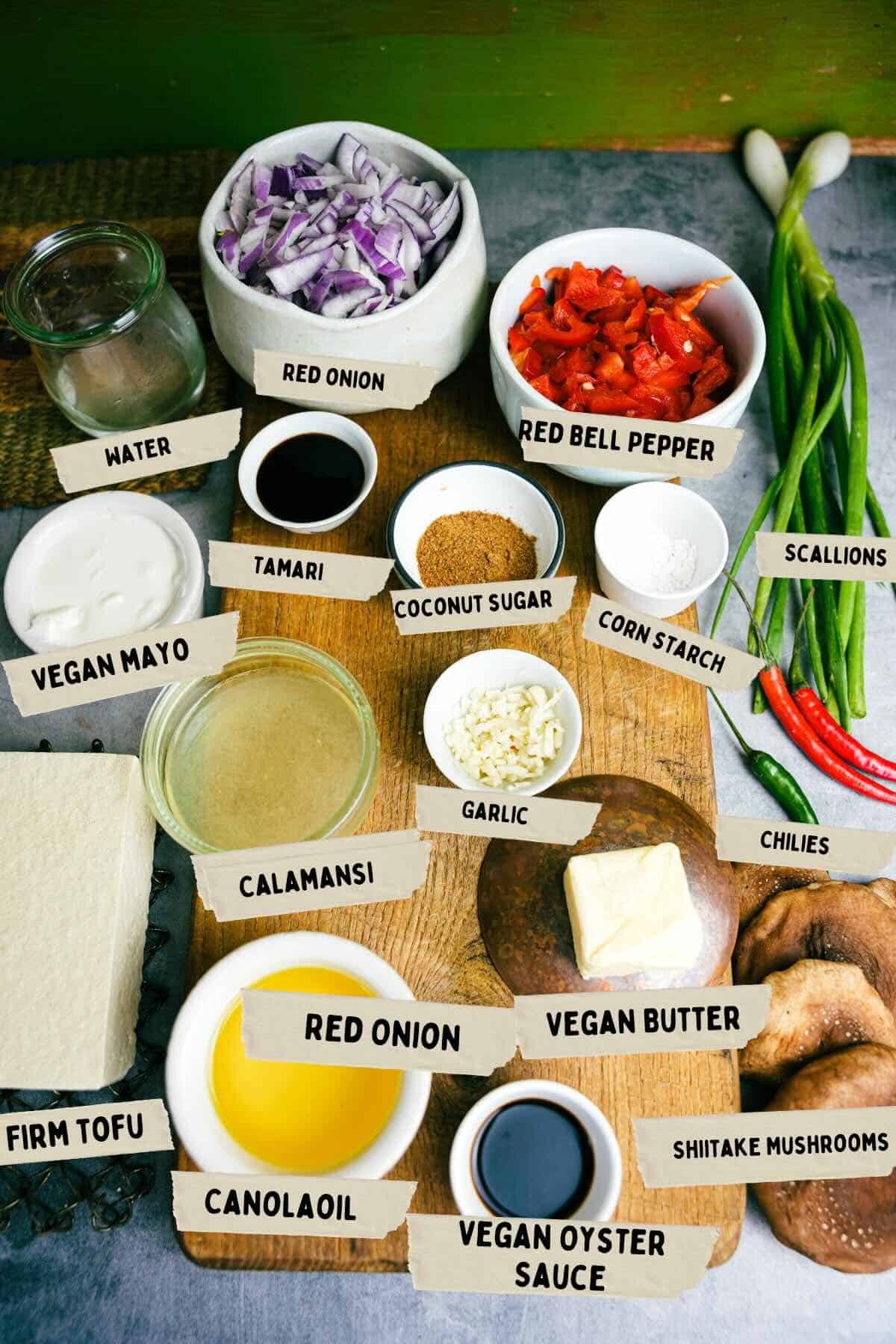
Coconut Sugar
Coconut sugar is a natural sweetener made from the sap of coconut palm tree flower buds. It has a rich caramel-like flavor with a hint of butterscotch and a lower glycemic index compared to cane sugar, making it a popular choice for those seeking a healthier sweetener option. I use it in my bandrek and kuih dadar. You can subsitute brown sugar or palm sugar (which also makes the BEST filling for klepon!)
Calamansi
Calamansi, also known as Philippine lime or calamondin, is a small citrus fruit that is native to Southeast Asia, particularly the Philippines. It is a cross between a mandarin orange and a kumquat, and is known for its unique flavor and versatility in culinary applications. Calamansi has a tangy, sour taste with a hint of sweetness. If you can’t find it at your local Asian food store, you can substitute lemon or lime juice in it’s place for this recipe.
Vegan mayonnaise
Vegan mayo is usually made from plant-based fats which have been emulsified with some flavored vegan protein base. I know, I didn’t just make it sounds that exciting, but damnit, I could bathe in the stuff! Vegan mayonnaise tends to be lower in saturated fat, compared to regular mayonnaise and has no cholesterol, making it a healthier option.
Vegan oyster sauce
Vegan oyster sauce is a plant-based alternative to the traditional oyster sauce that is commonly used in Asian cuisine. Instead of being made from oysters or other shellfish, vegan oyster sauce is typically crafted from mushrooms, yeasts, sweeteners, and other plant-based ingredients to replicate the umami-rich flavor and thick, glossy consistency of traditional oyster sauce. It is available online and at your local Asian food store. You can subsitute vegan fish sauce or nuoc cham.
Bird’s eye chilies
Bird's eye chilies, also known as Thai chilies, are small and fiery hot peppers commonly used in dishes like pad woon sen, tom yum fried rice, and urap sayur. These slender peppers, measuring 1-2 inches, vary in color from green to red as they mature, providing a sharp, spicy, and slightly fruity taste. With a Scoville heat rating ranging from 50,000 to 100,000 units, similar to cayenne peppers, they add considerable heat to dishes without overpowering other flavors.
Caution is crucial during handling due to their high capsaicin content, which can cause skin and eye irritation. If you can't find them you can use Korean chilies, Fresno peppers, or even Jalapeños.
📖 How to make perfect vegan sisig
You wanna see how this crispy one-pan dish gets made? I will grab you by the hand and walk you through the whole process. Or you can follow along with the easy-to-print recipe card towards the bottom of this page.

Step 1
Press the tofu for 30 minutes to remove excess water. Either use a tofu press, or wrap the tofu between paper towels or a clean kitchen towel, and place a heavy object, such as a cast iron skillet, on top. Cut the tofu into ½ inch cubes (just over 1 cm.)

Step 2
Heat 2 tablespoons of canola oil or other neutral-tasting cooking oil over medium-high heat in a wok or large frying pan. Add the tofu and cook until for 8-9 minutes, flipping the pieces frequently until golden and crispy on all sides.
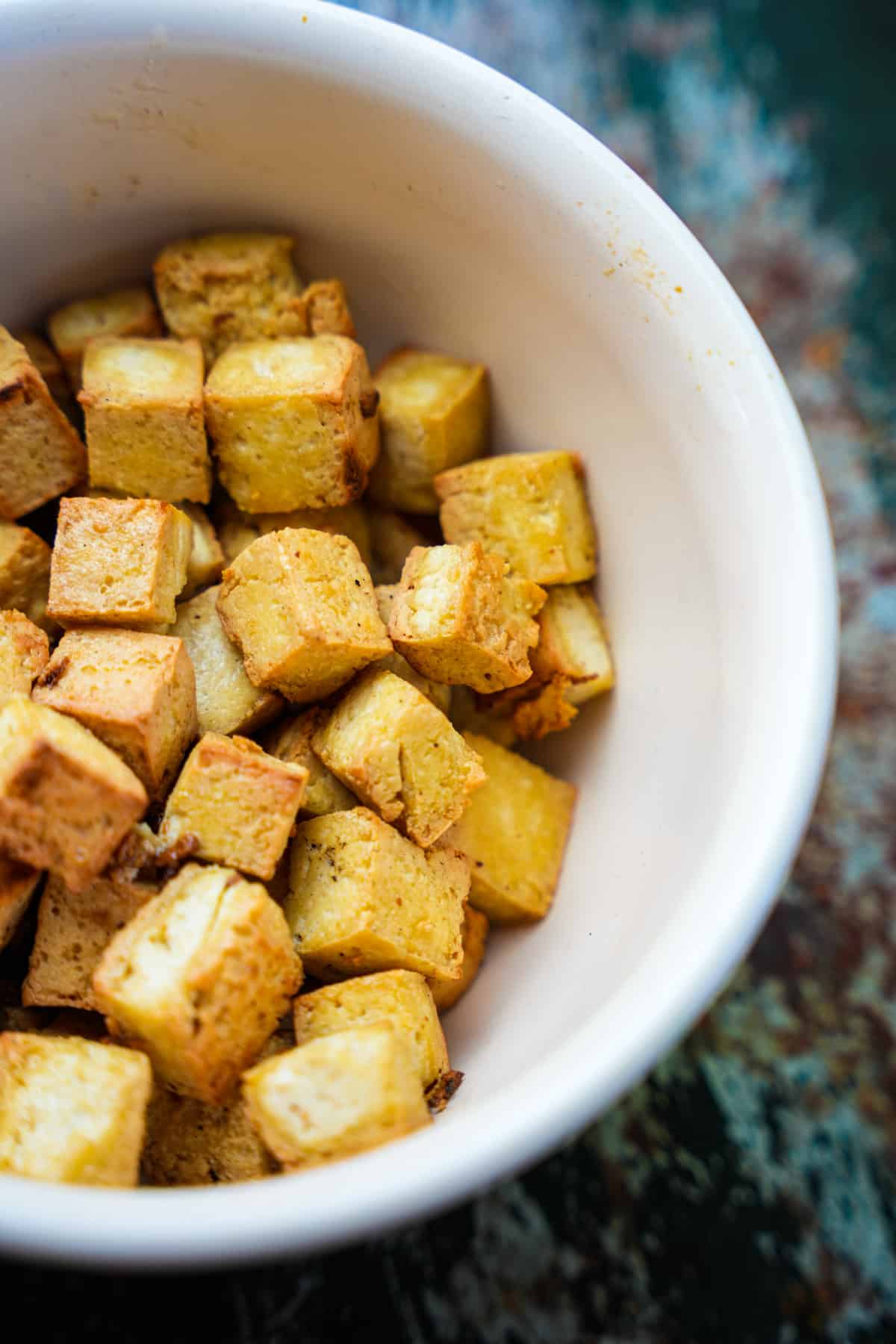
Step 3
Once cooked, remove the tofu from the pan and set aside.
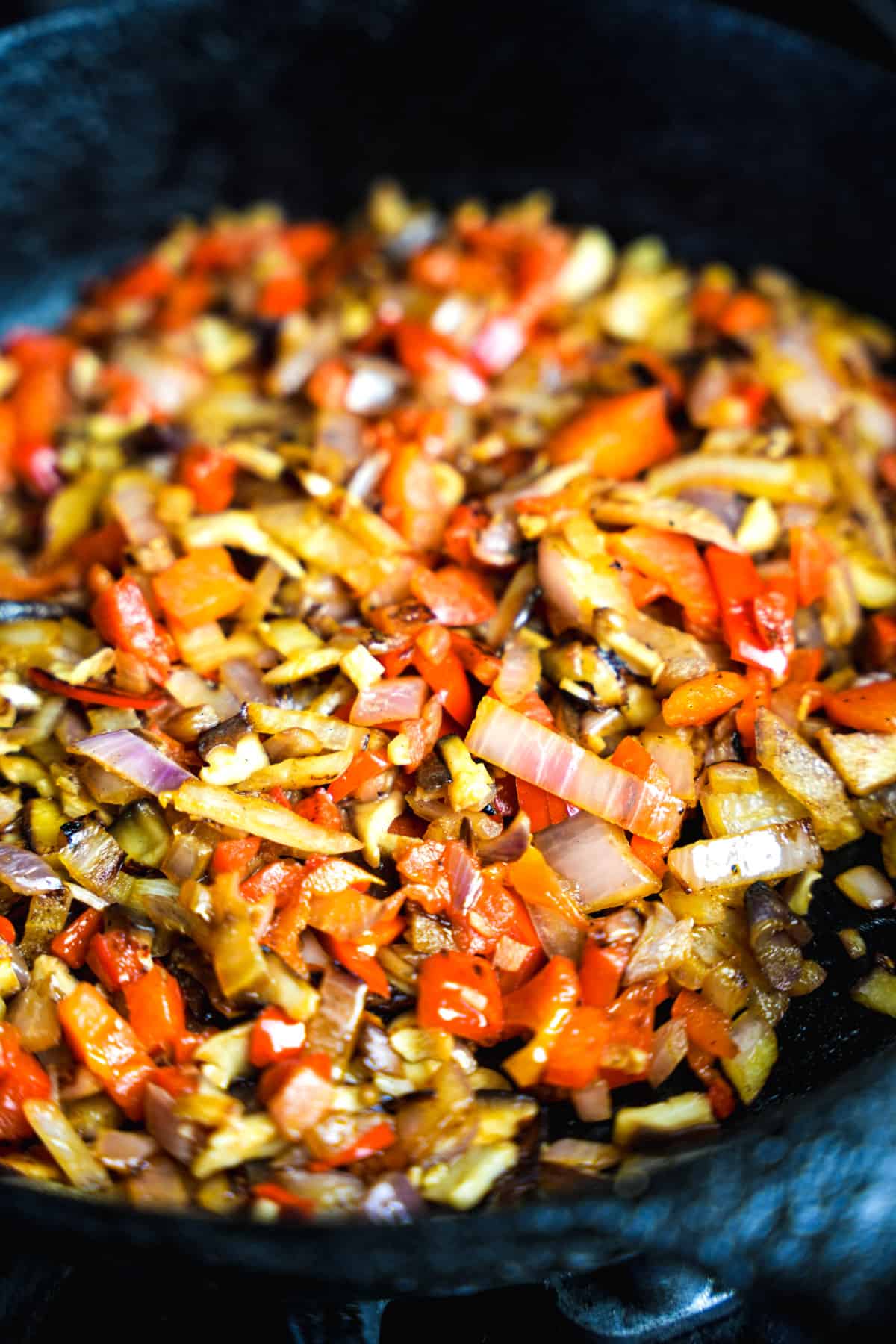
Step 4
Lower the flame to medium and in the same pan or wok, melt the vegan butter.
When the butter is completely melted, stir-fry the diced red onion, minced garlic, diced red bell pepper, and sliced shiitake mushrooms for about 5 minutes

Step 5
Dissolve the cornstarch in the water in a cup using the tines of a fork.
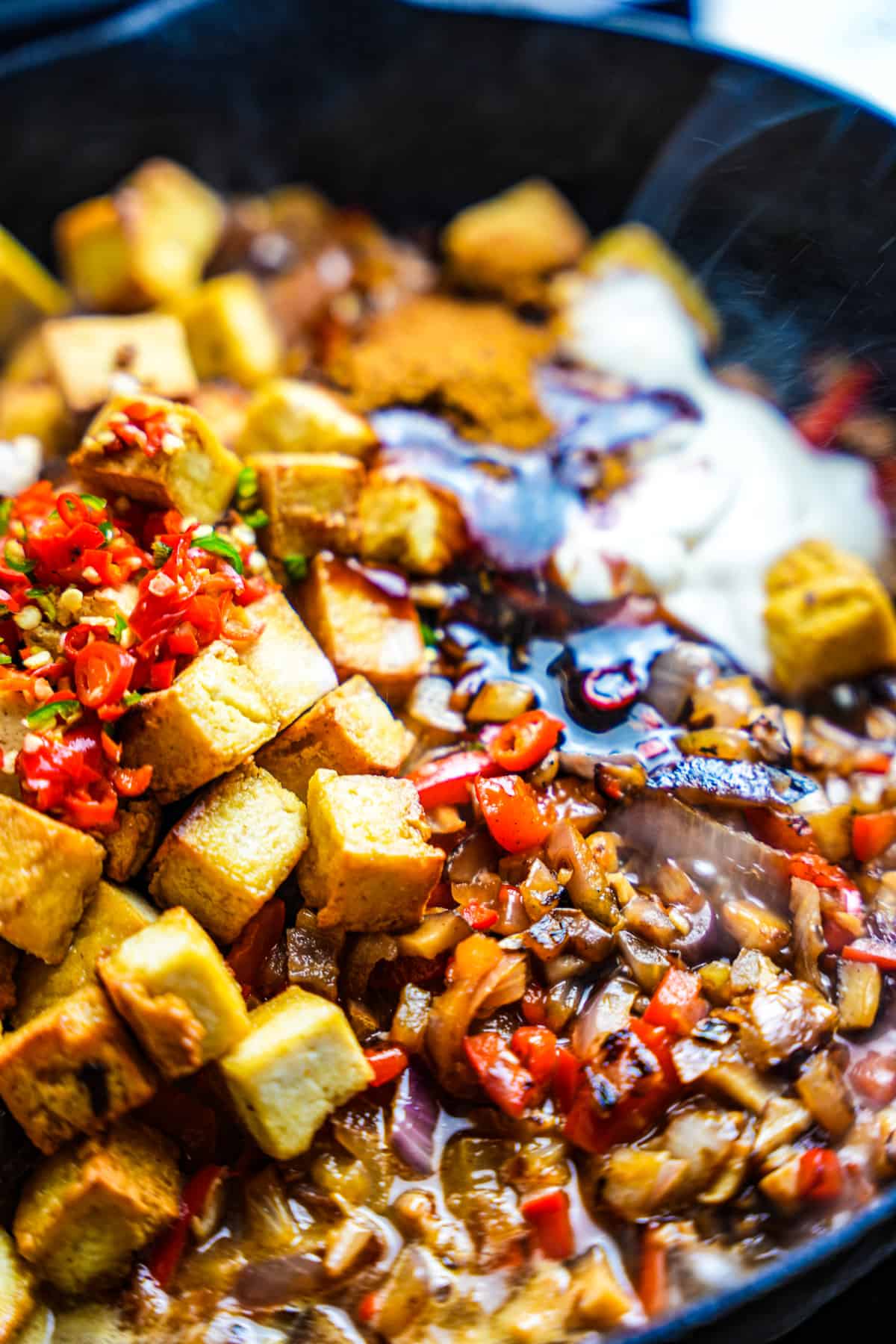
Step 6
Add the cooked tofu, cornstarch mixture, and all remaining ingredients into the pan with the cooked vegetables. Stir for two minutes to coat the vegetables evenly with the sauce.

Step 7
Serve the tofu sisig into an attractive serving dish, or directly in the sizzling hot pan and garnish with the thinly sliced scallions on top, with a side of achara.
💡Serving ideas
Want to kick the heat up on your tofu? Drizzle it with some homemade Nước Chấm or Nam Prik Pao!
You can serve the tofu over Nasi Uduk Betawi (pandan steamed coconut rice), alongside rice paper salad, or on top of thicccc udon noodles from Indonesia.
Of course, it is great with other classic Filipino dishes like ginisang munggo and kalabasa.
Want to finish this meal with a killer Asian dessert? You could do worse than Filipino taho, Vietnamese Flan, Kuih dadar, or Che Ba Mau (the cold, three-color treat of a lifetime)! Martabak or Vietnamese coconut ice cream bars, could be a great choice too.
💡Top tip
Some sisig recipes call for adding the chilies earlier on in the recipe. I leave mine towards the end for a couple of reasons. One is that cooking with very spicy chilies makes the air in your kitchen unnecessarily hard and unpleasant to breath! Less cooking time reduces that situation. The other is that the mildly cooked peppers brighten up and intensify the flavors of this dish more than wilted, cooked peppers do, and I love that!
🤷♀️Recipe FAQs
One popular belief is that sisig originated in the culinary capital of the Philippines, Pampanga, in the 1970s. It is said to have started as a way to repurpose leftover parts of a pig's head, such as the ears, cheeks, and snout, which were traditionally considered less desirable cuts of meat. These parts were initially boiled, grilled, or roasted, but eventually, they were chopped up, seasoned with vinegar, calamansi (a local citrus fruit), and spices, and then fried until crispy. The result was a flavorful and crispy dish that became a hit among locals and eventually gained popularity nationwide.
Another story attributes the invention of sisig to Lucia Cunanan, a restaurateur from Angeles City in Pampanga, who is said to have created the dish in the 1960s. According to this story, Cunanan originally served sisig as a salad with boiled pig's ears, but eventually added more ingredients and transformed it into a sizzling and crispy dish.
In modern times, popular Filipino restaurants like Max’s (which is not an international chain) started by Maximo Gimenez, began serving versions of sisig made with tofu and other fresh ingredients.
Filipinos are passionate about sisig for several reasons. Sisig has a diverse flavor profile, which includes savory, tangy, creamy, greasy, rich, and crispy textures, creating a symphony of flavors that is both satisfying and addictive.
The combination of marinated and grilled or fried meat, typically pork, along with onions, garlic, and chili peppers, results in a tantalizing taste that keeps Filipinos coming back for more. It has become a staple pulutan (a dish commonly served with alcoholic beverages) and ulam (main dish) in Filipino cuisine. The use of calamansi, a Filipino citrus fruit, adds a burst of acidity that enhances and enlivens the overall taste of sisig.
Sisig's unique presentation adds to its appeal. Sisig is often served on a sizzling plate, which not only adds an element of drama to the dish but also keeps the dish hot and crispy. The sizzling hot plate creates an interactive dining experience, as diners can hear the enticing sizzle and see the steam rising from the dish, making it a memorable and exciting meal.
The history and cultural significance of sisig make it special to Filipinos. The dish originated from humble beginnings as a way to use leftover pork parts that were often discarded. The name sisig comes from the old Tagalog word sisigan, which means to make sour, reflecting the traditional method of marinating the meat in vinegar or citrus juice. Despite its humble origins, sisig has evolved into a beloved dish that has gained international recognition, with many variations and interpretations by different regions and restaurants.
🥶Storage: Allow the tofu sisig to cool completely before storing. Transfer the leftover tofu sisig to an airtight container and store it in the refrigerator for up to 3 days.
Reheating: When ready to reheat, there are two recommended methods:
🔥Stovetop Reheating
In a pan or wok, heat a small amount of oil over medium heat.
Add the leftover tofu sisig to the pan and stir-fry for a few minutes until heated through.
Stir occasionally to ensure even heating.
Add a little extra water if the dish looks like it could be loosened up a bit.
Once heated, remove from heat and serve hot, garnished with scallions.
🔥Oven Reheating
Preheat your oven to 350°F (175°C).
Place the leftover tofu sisig in an oven-safe dish.
Cover the dish with aluminum foil to prevent drying out.
Bake in the preheated oven for 20 minutes, or until heated through.
Remove from the oven and carefully remove the aluminum foil.
Serve hot and garnish with freshly sliced scallions.
☢️Avoid microwaving the leftover tofu sisig, as it may result in a loss of texture and become soggy.
With these storage and reheating instructions, you can enjoy your leftover tofu sisig with minimal effort while maintaining its delicious flavors!
✌️Other dishes that go great with this:
Say Hi on Social! 👋
Follow me on Instagram & Facebook for more recipes.
❤️Love this recipe? It helps me out greatly if you leave a 5-star 🌟🌟🌟🌟🌟rating in the recipe card below and maybe even leave me a lovey-dovey comment too!

Tofu sisig (crispy vegan Filipino tofu)
Equipment
Ingredients
- 14 oz. extra firm tofu
- 3 tablespoons canola oil or vegetable oil
- 2 tablespoons vegan butter
- 1 medium size red onion diced
- 2 cloves garlic minced
- 1 small red bell pepper diced
- 6 medium size shiitake mushrooms sliced
- ¼ cup water
- ½ teaspoon cornstarch
- 1 tablespoon tamari
- 4 teaspoons vegan oyster sauce
- 2 tablespoons lemon juice or calamansi if available
- 1 tablespoon coconut sugar or regular sugar
- ¼ cup vegan mayonnaise
- 3 bird’s eye chilies thinly sliced
- 2 scallions cut into long thin strips to garnish
Instructions
- Prepare the tofu by pressing it to remove excess water. Place the tofu between paper towels or a clean kitchen towel, and place a heavy object, such as a cast iron skillet, on top. Let it sit for about 30 minutes to remove excess moisture.
- Once the tofu is pressed, cut it into small ½ inch cubes (just over 1 cm.)
- In a large pan or wok, heat 2 tablespoons of canola oil or other neutral-tasting cooking oil over medium-high heat.
- After 60 seconds when the oil is hot, add the tofu cubes and cook until they are golden brown and crispy on all sides. This will take about 8-9 minutes. Once cooked, using a slotted spoon or spider, remove the tofu from the pan and set it aside.
- Lower the flame to medium and in the same pan or wok, melt 2 tablespoons of vegan butter.
- When the butter is completely melted, add the diced red onion, minced garlic, diced red bell pepper, and sliced shiitake mushrooms to the pan. Stir-fry until the vegetables are tender and fragrant, about 5 minutes.
- Using the tines of a fork, dissolve the cornstarch into the water in a small cup.
- Add the cooked tofu, cornstarch mixture, and all remaining ingredients into the pan with the cooked vegetables. Stir for two minutes to coat the vegetables evenly with the sauce.
- Place the tofu sisig into an attractive serving dish or directly in the sizzling hot pan and garnish with the thinly sliced scallions on top.


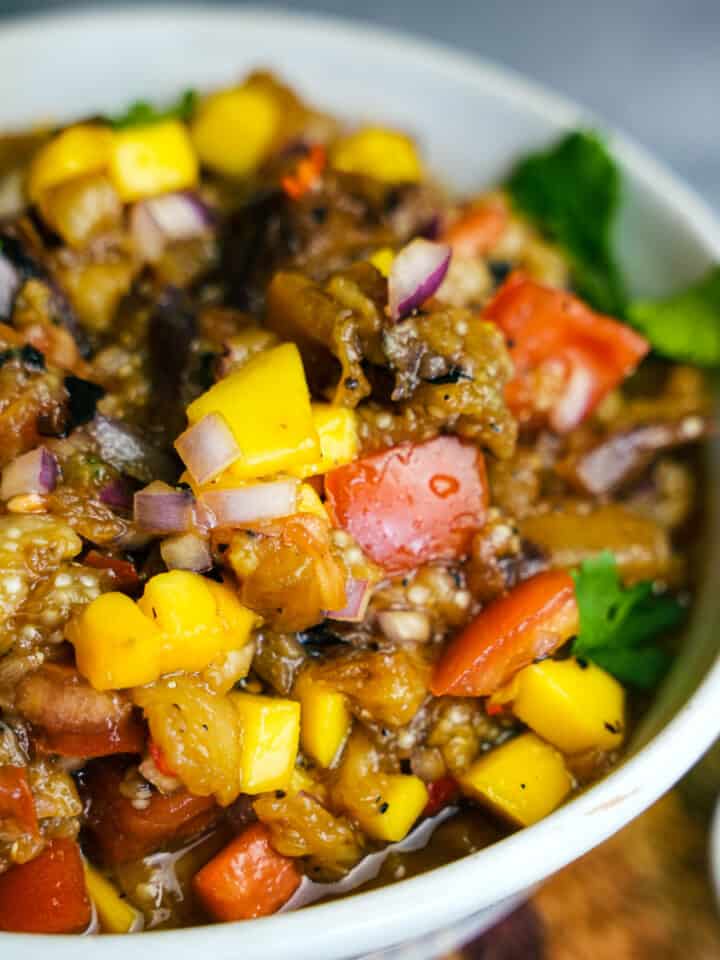




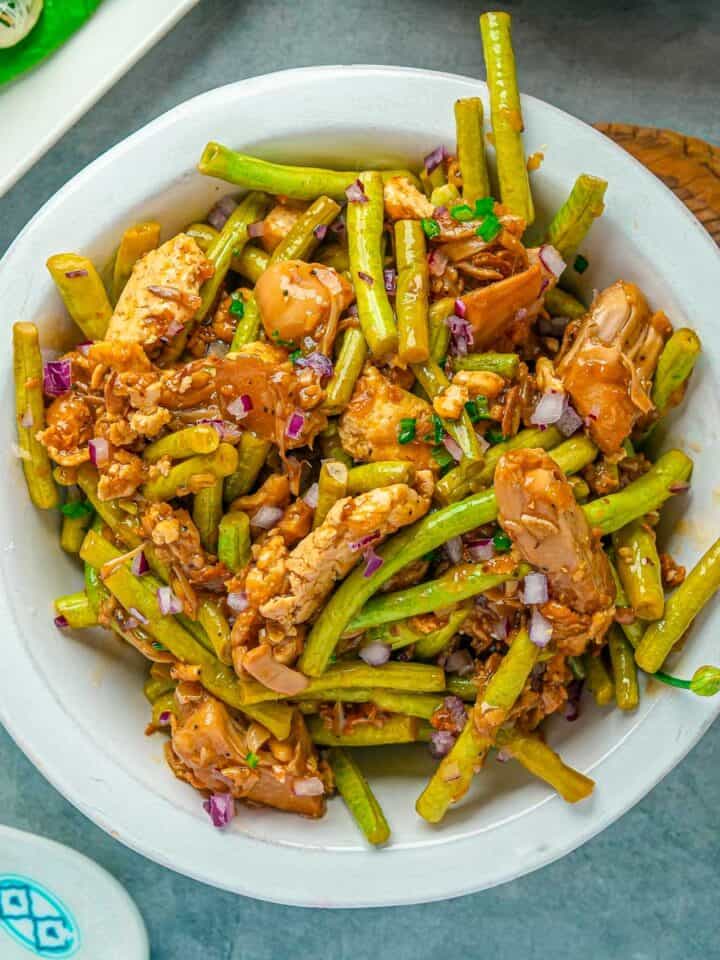


Heather
a great recipe definitely one of our favorite meals. The mayonnaise makes a very creamy sauce. Thank you Adam!
Heva
I am a big fan of Cinnamon Snail’s range of vegan recipes. This is one of my favourite dishes and it never fails to make my day! It's a delicious and nutritious meal that always hits the spot. If you haven't tried it yet, you don't know what you're missing.
Adam Sobel
Sisig is the BOMB. I am so glad you love this one as much as I do. Have you tried my tofu katsu recipe yet? The texture is crazy meat like.
HG
I love this recipe. At first, adding the mayo through me off a bit. It wasn't an ingredient I was expecting in a dish like this. But what a difference it made. Added a whole new dimension to Asian cooking ( for me ). Delicious!
KRB
Made this tonight - came together very quickly and the flavor was good. I was not so sure about mayo in a dish like this but it worked! Made a nice sauce, which went great served over rice. I had to leave the chilis out since my child is spice-averse, but I think it would only have been better with a little heat.
Adam Sobel
That tiny bit of mayo is important for carrying the tangy and spicy notes of the dish. Glad you liked it ❤️
Cheryl
Just a handful of ingredients made a delicious week night meal! The addition of the vegan Mayo added a rich and silky mouth feel to the finished dish, it’s a definite make again!